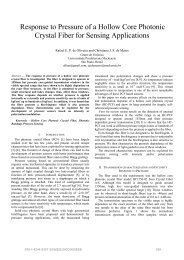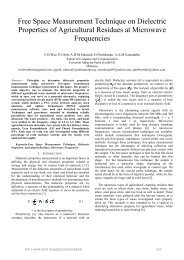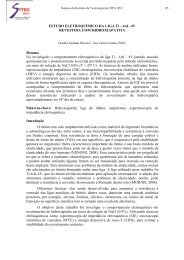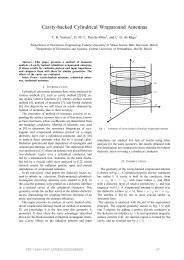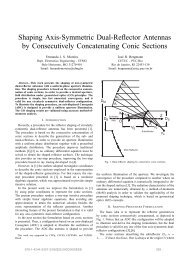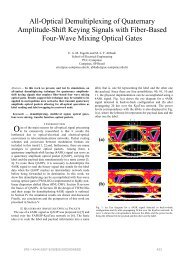A Variable Output Power, High Efficiency, Power Amplifier for the ...
A Variable Output Power, High Efficiency, Power Amplifier for the ...
A Variable Output Power, High Efficiency, Power Amplifier for the ...
Create successful ePaper yourself
Turn your PDF publications into a flip-book with our unique Google optimized e-Paper software.
efficiency <strong>the</strong> transistors are biased towards class B operation.The amplifier was designed <strong>for</strong> a drain supply (V D ) of 28V.A. Design ProcedureLarge-signal models were available <strong>for</strong> both transistorsfrom <strong>the</strong> manufacturers. Although <strong>the</strong>ir validity could bequestioned <strong>the</strong>y were later shown to well model <strong>the</strong> behaviourunder <strong>the</strong> conditions used in this design. Initially harmonicbalance,load-pull simulations were conducted in Agilent-ADS to establish a high power added efficiency (PAE) at <strong>the</strong>requested output power <strong>for</strong> <strong>the</strong> power stage. The trade-offbetween output power, gain, efficiency and quiescent pointwas observed in <strong>the</strong> simulations and an optimal quiescentcurrent of around 10 % and 5 % of <strong>the</strong> maximum saturateddrain current <strong>for</strong> both power and driver stage respectivelywere determined to achieve <strong>the</strong> desired objectives of outputpower and efficiency. Independent load and source-pullsimulations were <strong>the</strong>n per<strong>for</strong>med <strong>for</strong> both stages. Initially,load and source-pull simulations were per<strong>for</strong>med with idealcomponents and ideal optimum load and source impedanceswere found. Independently both transistors were stabilized tounconditional stability by fulfilling <strong>the</strong> Rollet’s stabilitycriterion [8] (K > 1). This was achieved by adding a parallelresistance with capacitance in series at <strong>the</strong> input, effectivelyreducing <strong>the</strong> low frequency gain. λ/4 transmission lines wereused in <strong>the</strong> biasing networks to improve isolation at RFfrequency. Load and source pull simulation were per<strong>for</strong>medagain to achieve optimum impedances <strong>for</strong> <strong>the</strong> two stages. Theoptimum load and source impedances found are summarizedTable I. A maximum optimum driver stage quiescent current(IDQ (DS) ) was found to be 32 mA at an optimum power stagequiescent current (IDQ (PS) ) of 123 mA.TABLE IOPTIMUM LOAD AND SOURCE IMPEDANCE AND QUIESSENTCURRENT<strong>Power</strong> stage(PS)Driver stage(DS)Z LOAD[]Z SOURCE[]I DQ[mA]6.2 – j10.3 6.7 – j26.5 1236.0 – j6.6 5.0 – j30.0 32B. Design ImplementationThe matching networks were realized using micro-striplines toge<strong>the</strong>r with open stubs in low pass <strong>for</strong>m. Inputmatching was designed to achieve good return loss. It wasimplemented using a tapered line to compensate <strong>for</strong> some of<strong>the</strong> series capacitance introduces by <strong>the</strong> capacitor in <strong>the</strong>stabilizing network. The inter-stage matching network wasdesigned to minimize mismatch losses and <strong>for</strong> maximumtransfer of power between <strong>the</strong> two stages. The outputmatching network was designed <strong>for</strong> minimum loss to <strong>the</strong> loadand a simulated insertion loss < 0.1 dB was achieved <strong>for</strong> afrequency range of 200 MHz with centre frequency of2.45 GHz. Momentum simulations were used to verify <strong>the</strong>impedances created by <strong>the</strong> linear matching networks.C. Design RealizationThe amplifier was built on Rogers RO4003 substrate with adielectric constant ε r of 3.66 and thickness of 0.51 mm. Fig. 2shows a prototype <strong>for</strong> <strong>the</strong> designed PA.Fig. 2 <strong>Power</strong> amplifier prototypeVia holes were manually fabricated. Thermal control wasestablished using an aluminium heat sink with a cooling fan.Bias was separately controllable <strong>for</strong> <strong>the</strong> two stages in <strong>the</strong>initial tests but was later fixed <strong>for</strong> <strong>the</strong> power stage andintegrated with a temperature-gain control circuitry. Thematching networks were made on separate substrates so thatlinear per<strong>for</strong>mance of <strong>the</strong> networks could be measured andverified individually.III. AMPLIFIER EVALUATIONThe design process was totally based on a model approach.Small signal evaluation was <strong>the</strong>re<strong>for</strong>e used to verify <strong>the</strong>correctness of <strong>the</strong> models used <strong>the</strong>reby validating <strong>the</strong> designprocess.A. Small Signal Per<strong>for</strong>manceThe small-signal s-parameters of <strong>the</strong> full amplifier are showin Fig. 3.S-Parameters [dB]40200-20-40S21simS11simS22simS21measS22measS11meas2.0 2.2 2.4 2.6 2.8 3.0ƒ [GHz]Fig. 3 Measured and simulated small signal s-parameters at V D = 28 V andmaximum drain current <strong>for</strong> <strong>the</strong> driver stage.It can be observed that a small-signal gain of 27 dB withinput and output reflections less than -15 dB in <strong>the</strong> operatingfrequency is achieved. The K factor was measured to > 4 over<strong>the</strong> frequency band from 1 kHz – 10 GHz. This is mainlybecause both <strong>the</strong> stages were individually stabilized be<strong>for</strong>ecascading. Compared to simulations, gain measurements2009 SBMO/IEEE MTT-S International Microwave & Optoelectronics Conference (IMOC 2009) 822



